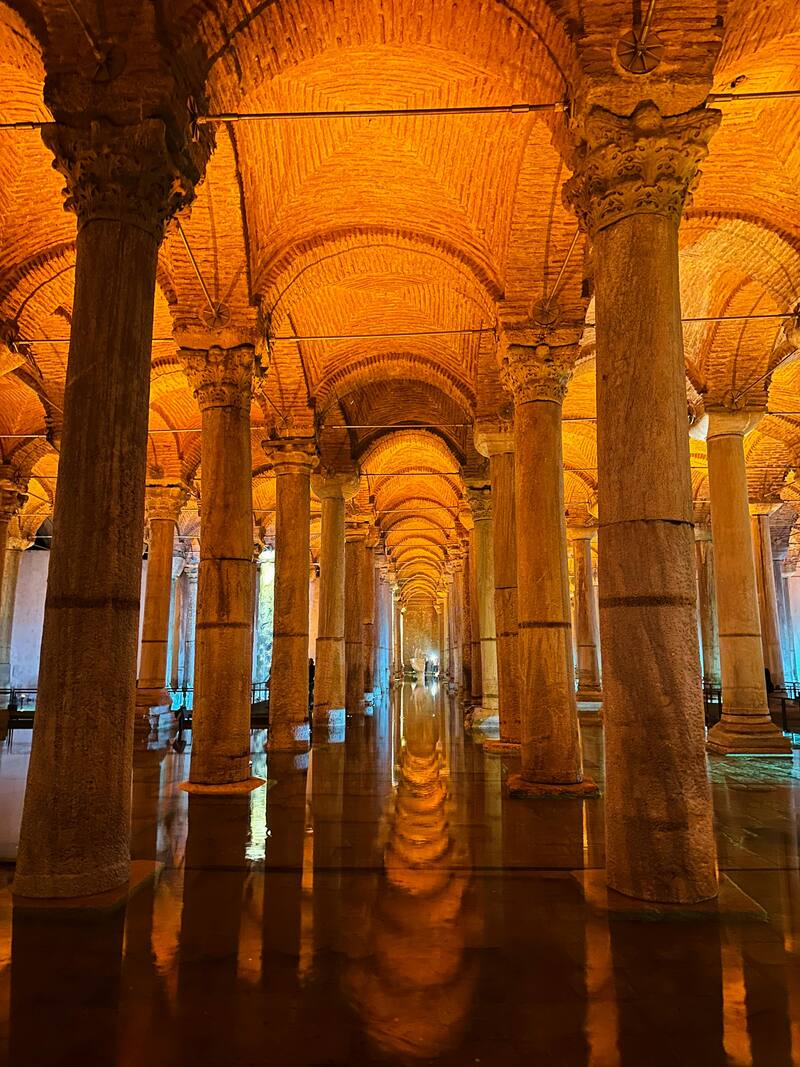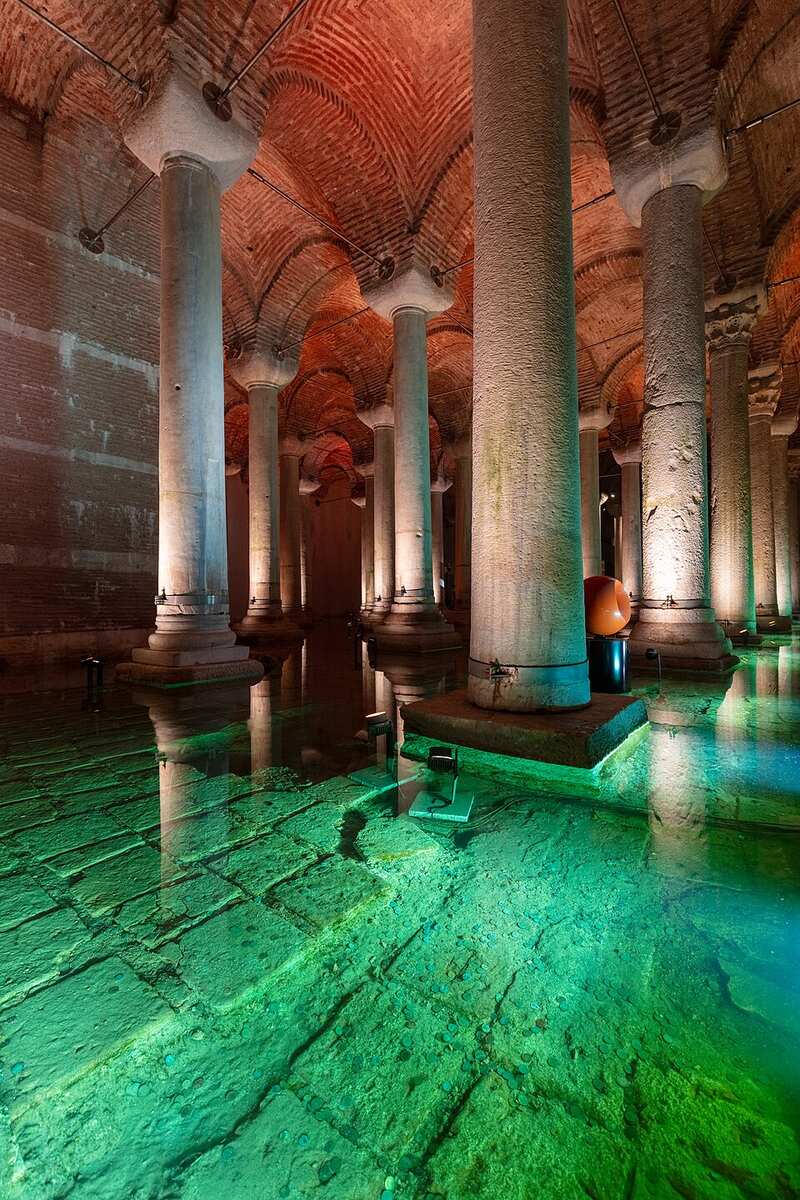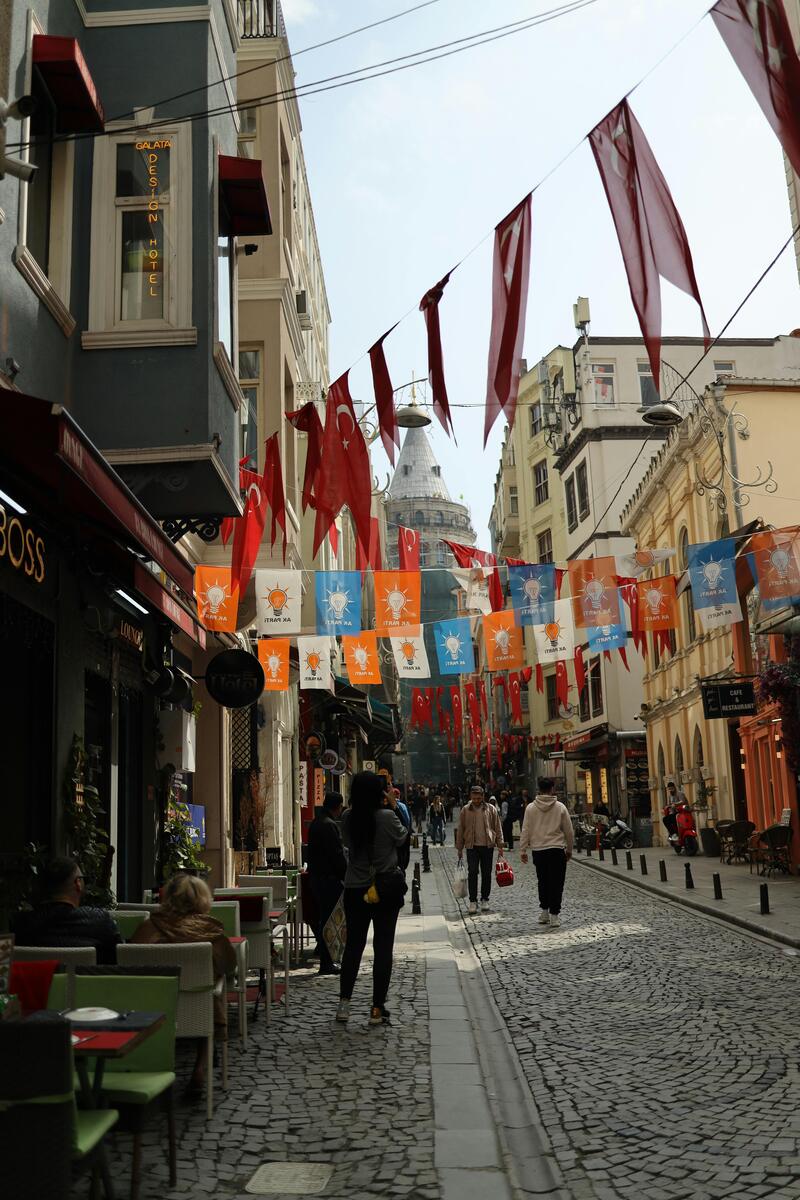those 52 stone steps into the Basilica Cistern feels like stepping through a portal into another world—one where Byzantine engineering meets Hollywood mystery. I mean, there’s something almost surreal about finding yourself in a vast underground cathedral where marble columns rise from dark, still waters like ancient sentinels guarding secrets from the 6th century.
Perhaps no other historical site in Istanbul captures the imagination quite like this subterranean marvel. It’s not just the sheer scale of the place—though 336 columns supporting a vaulted ceiling 30 feet underground is pretty impressive—it’s the atmosphere. The soft lighting, the gentle sound of water droplets, the way those famous Medusa heads seem to watch you from their upside-down and sideways positions… it’s haunting in the best possible way.
Whether you’re planning your first visit to Istanbul or you’re one of those travelers who thinks they’ve seen everything the city has to offer, the Basilica Cistern deserves a spot at the top of your list. This complete guide will help you navigate everything from the fascinating Byzantine history to practical visiting tips that most tourists never learn.
The Remarkable History Behind Istanbul’s Underground Cathedral
Emperor Justinian’s Ambitious Vision
Back in 532 AD, when most of the world was struggling with basic infrastructure, Byzantine Emperor Justinian I was dreaming big—really big. The Basilica Cistern, known locally as Yerebatan Sarnıcı (which literally means “sunken palace”), wasn’t just another construction project. It was part of Justinian’s massive rebuilding program following the devastating Nika Riots that had destroyed much of Constantinople.
Think about the engineering challenges for a moment. This was the 6th century, and Justinian’s architects had to create an underground space measuring 138 meters long by 65 meters wide, capable of storing 80,000 cubic meters of water. That’s equivalent to about 32 Olympic-sized swimming pools, all hidden beneath the bustling streets of the imperial capital.
The construction required around 7,000 workers—mostly slaves—who labored for months to create what would become the largest covered cistern in Istanbul. The fact that this underground wonder has survived earthquakes, conquests, and fifteen centuries of urban development above it speaks volumes about Byzantine engineering prowess.
The Great Rediscovery
Here’s where the story gets really interesting, I think. After the Ottoman conquest in 1453, the cistern gradually fell out of use and was essentially forgotten. Local residents knew there was something beneath their houses—they could fish through holes in their basement floors and hear strange echoes—but nobody really understood what lay below.
Enter Petrus Gyllius, a Dutch scholar who arrived in Istanbul in 1545, searching for Byzantine antiquities. When locals told him about the mysterious underground space where they could catch fish from their basements, he convinced them to lower him down with torches. What he discovered was this magnificent architectural treasure that had been lost for nearly a century.
Can you imagine that moment? Stepping into this vast, columned hall with just torchlight, realizing you’ve stumbled upon one of the great engineering marvels of the ancient world? It must have felt like discovering an underground city.
Architectural Marvels That Still Baffle Engineers
The Forest of Columns
Walking through the Basilica Cistern, you’re surrounded by 336 marble columns arranged in 12 rows of 28 columns each. But here’s what makes this really fascinating—most of these columns are actually recycled from earlier Roman and Byzantine structures. It’s like the world’s most elegant architectural recycling project.
Each column stands 9 meters (about 30 feet) tall and features different architectural styles. You’ll see Corinthian capitals with their elaborate acanthus leaves, Ionic columns with their characteristic scrolled volutes, and even some Doric columns with their simpler, more austere design. This mix of styles creates an almost mystical forest effect, especially with the atmospheric lighting installed in the modern era.
The engineering is remarkable when you consider the weight distribution. Each column supports tons of stone and earth above, yet they’ve stood for nearly 1,500 years. Byzantine architects understood load-bearing principles that some medieval builders would struggle with centuries later.
The Mysterious Medusa Heads
Let’s talk about the cistern’s most photographed features—those two Medusa head column bases that have puzzled visitors and scholars for centuries. One sits upside down, the other sideways, both serving as supports for massive marble columns in the northwest corner of the cistern.
Nobody knows for certain why these Medusa heads were placed in these unusual positions. Some theories suggest it was to neutralize the gorgon’s mythical power to turn viewers to stone. Others argue it was simply practical—the heads were repurposed from a Roman temple and positioned however they fit best structurally.
What we do know is that these heads were likely carved in the late Roman period, possibly for a temple or public building. The craftsmanship is extraordinary—you can see individual curls in Medusa’s serpentine hair and the detailed expressions on her face. Standing before them, particularly the upside-down head, creates an oddly disorienting experience that adds to the cistern’s otherworldly atmosphere.
Visiting the Basilica Cistern: What You Need to Know
Tickets, Timing, and Practical Details
The Basilica Cistern operates daily from 9:00 AM to 6:00 PM, though these hours can extend during summer months and may be shorter in winter. As of 2025, entrance fees are around 600-900 Turkish Lira (roughly $18-27 USD), depending on the season and any special exhibitions running.
Here’s a pro tip that most guidebooks don’t mention: the cistern gets incredibly crowded between 10 AM and 4 PM, especially when cruise ships are in port. If you want that mystical, contemplative experience with the columns, aim for the first entrance slot at 9 AM or visit after 4:30 PM. The lighting becomes even more dramatic in late afternoon, creating better photography conditions too.
You can purchase tickets online or at the entrance, but I’d recommend buying them in advance during peak season (April through October). The cistern has a daily visitor limit to protect the structure, and popular time slots can sell out, particularly on weekends and holidays.
What to Expect During Your Visit
The descent into the cistern begins with a 52-step stone staircase that takes you about 8 meters underground. The temperature down there stays around 13°C (55°F) year-round, so bring a light jacket even on hot summer days. The humidity is quite high, which helps preserve the structure but can make the air feel thick.
Once inside, elevated wooden walkways guide you through the space, allowing you to walk among the columns without damaging the original floor or disturbing the shallow water that still covers parts of the cistern. The entire visit typically takes 30-45 minutes, though photography enthusiasts often spend longer capturing the perfect shot of those Medusa heads.
The cistern features classical music playing softly in the background, adding to the atmospheric experience. Some visitors find this enhances the mystical feeling, while others prefer the natural acoustics of the space. The lighting system uses LED fixtures positioned to highlight the columns’ architectural details without damaging the historic materials.
Photography Tips for the Perfect Underground Shots
Photography is allowed throughout the cistern, but there are some tricks to getting great shots in this challenging environment. The lighting is quite dim, so you’ll need to adjust your camera settings accordingly—think higher ISO (1600-3200), wider aperture (f/1.8-2.8), and possibly a tripod for steadier shots.
The Medusa heads are the most popular photo subjects, but they’re also the most crowded spots. Be patient and wait for gaps in the crowd, or consider capturing them from different angles that most tourists miss. The upside-down head, in particular, creates interesting reflection effects in the water below.
For wider shots of the column forest, position yourself at the corners of the walkway system where you can capture multiple rows of columns receding into the atmospheric lighting. The interplay of light and shadow on the brick vaulting above creates dramatic compositions that showcase the cistern’s massive scale.
Beyond the Basilica Cistern: Connecting Your Istanbul Historical Journey
Nearby Historical Sites
The beauty of visiting the Basilica Cistern is its location in the heart of Istanbul’s historical peninsula. You’re literally walking distance from some of the city’s most important sites. Our comprehensive guide to Istanbul’s historical sites shows how to plan an efficient route that includes the cistern as part of a larger historical exploration.
Hagia Sophia sits just 150 meters northeast of the cistern entrance—an easy 2-minute walk that takes you from Byzantine engineering marvel to architectural wonder above ground. The Blue Mosque is equally close, allowing you to experience the evolution of religious architecture from Christian Byzantine to Islamic Ottoman in a single afternoon.
If you’re fascinated by Istanbul’s other underground wonders, the nearby Binbirdirek Cistern (Cistern of Philoxenos) offers a quieter, less touristy underground experience. Built in the 4th century, it’s actually older than the Basilica Cistern and sees far fewer visitors, creating opportunities for more contemplative exploration.
Ottoman Palace Connections
The cistern’s history intertwines with Topkapi Palace, the Ottoman administrative and residential center that relied on the cistern’s water supply for centuries. After the conquest of Constantinople, the Ottomans recognized the cistern’s value and maintained it specifically to serve the palace complex.
Understanding this connection adds depth to visits to both sites. The palace’s elaborate gardens, fountains, and hammams all depended on the steady water supply that the cistern provided. It’s a reminder that these historical sites weren’t just monuments—they were functional parts of a living imperial capital.
The Science Behind the Underground Marvel
Byzantine Water Engineering
The Basilica Cistern represents just one component of Constantinople’s sophisticated water management system. Water reached the cistern through the Hadrian Aqueduct, which brought fresh water from springs in the Belgrade Forest, about 20 kilometers north of the city.
The engineering challenges were immense. Byzantine engineers had to calculate precise gradients to ensure water flowed steadily without creating pressure that could damage the infrastructure. They also needed to account for seasonal variations in water supply and the demands of a growing imperial capital.
The cistern’s design includes filtration systems that removed sediments and impurities before water reached the palace. Settling chambers allowed particles to sink, while the column spacing created gentle currents that prevented stagnation. It’s a level of urban planning that some cities struggle to achieve today.
Conservation Challenges in the Modern Era
Maintaining a 1,500-year-old underground structure in a modern metropolis creates unique challenges. Istanbul’s seismic activity poses constant threats, while urban development above affects groundwater levels and structural stability.
The major restoration completed in 1987 addressed centuries of neglect and damage. Engineers reinforced the ceiling structure, improved drainage systems, and installed climate control to protect the columns from deterioration. The elevated walkway system protects the original floor while allowing public access.
Current conservation efforts focus on monitoring structural integrity, controlling humidity levels, and managing visitor impact. The daily visitor limits aren’t just about creating an exclusive experience—they’re essential for protecting this irreplaceable piece of architectural history.
Cultural Impact and Popular Culture
From Forgotten Ruin to Global Icon
The Basilica Cistern’s journey from forgotten underground space to international tourist destination reflects Istanbul’s broader relationship with its layered history. The 1987 opening as a public museum coincided with growing international interest in Byzantine heritage and Turkey’s cultural tourism development.
Hollywood discovered the cistern’s dramatic potential, using it as a location in films like “From Russia with Love” (1963) and “The International” (2009). These appearances introduced the cistern to global audiences and helped establish its reputation as one of Istanbul’s most atmospheric historical sites.
The cistern has also hosted concerts, art installations, and cultural events, demonstrating how historical spaces can serve contemporary cultural purposes while maintaining their historical integrity. The acoustics created by the vaulted ceilings and column spacing create a unique sonic environment for musical performances.
Planning Your Perfect Cistern Experience
Best Times for Different Types of Visitors
Photography enthusiasts should visit during the first hour of opening when crowds are minimal and you can spend time setting up shots without feeling rushed. The atmospheric lighting works particularly well for long exposure techniques that capture the interplay between artificial illumination and the cistern’s natural shadows.
History buffs might prefer late afternoon visits when they have more time to contemplate the space and read informational displays without crowds pressing behind them. This timing also allows for immediate visits to nearby sites like Hagia Sophia or the Blue Mosque afterward.
Families with children should consider mid-morning visits (around 10:30-11:30 AM) when kids are fresh but before the worst crowds arrive. The cistern’s mystical atmosphere captures children’s imagination, though the dim lighting and elevated walkways require adult supervision.
For those interested in seasonal visiting strategies, winter months offer smaller crowds and more intimate experiences, though shorter daylight hours limit time for combining multiple historical sites in a single day.
Making the Most of Your Underground Adventure
Consider downloading audio guide apps or joining guided tours that provide historical context about Byzantine water management and architectural techniques. Understanding the engineering challenges makes the cistern’s survival even more impressive.
Budget at least 45 minutes for your visit, though you could easily spend longer if you’re particularly interested in photography or architectural details. The elevated walkway system creates natural viewing points for different perspectives on the column arrangements and ceiling structure.
Don’t rush to the Medusa heads immediately—explore the entire space first to appreciate the cistern’s massive scale, then return to the famous columns for closer examination and photography. This approach helps you understand the overall architectural achievement before focusing on specific decorative elements.
Why the Basilica Cistern Matters Today
Standing in the Basilica Cistern, surrounded by those ancient columns and listening to the gentle echo of water drops, you’re not just seeing a tourist attraction—you’re experiencing one of humanity’s great engineering achievements. This underground cathedral represents the sophistication of Byzantine civilization and the remarkable preservation of cultural heritage through centuries of political and social change.
Perhaps what strikes me most about the cistern is how it connects us to the daily lives of people who lived 1,500 years ago. Every drop of water that flowed through this space sustained emperors and ordinary citizens alike. Every column represents the skill of craftsmen whose names we’ll never know but whose work continues to inspire wonder.
For modern visitors, the cistern offers something increasingly rare in our digital age—a space for quiet contemplation and genuine wonder. It reminds us that previous civilizations achieved remarkable things with tools and knowledge we might consider primitive. The fact that this structure has outlasted the empire that built it speaks to the enduring power of human creativity and engineering ambition.
Whether you’re exploring Istanbul’s comprehensive historical landscape or focusing specifically on Byzantine heritage, the Basilica Cistern provides an essential piece of the city’s complex cultural puzzle. It’s proof that sometimes the most extraordinary discoveries lie hidden beneath our feet, waiting for curious travelers to descend those stone steps and enter another world entirely.



